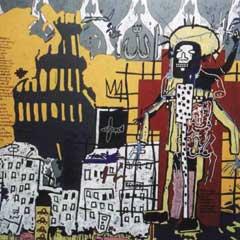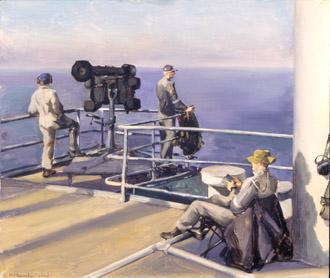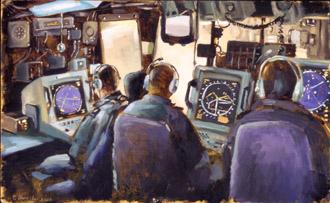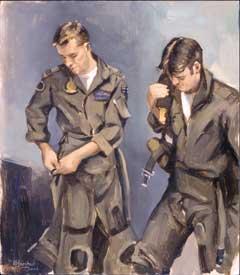War without boundaries: Australia and the ‘war against terrorism’
Curator's talk presented by Claire Baddeley on 20 March 2003 beside the exhibition
Welcome everyone to this introduction to the War Memorial’s latest exhibition in the Special Exhibition’s Gallery, War without boundaries: Australia and the ‘war against terrorism, on display until the 31st August 2003.
First, I’ll provide a general outline of the exhibition, its theme and aims, and then discuss a number of individual art works, items and objects in more detail.
This exhibition aims to communicate to visitors, in a number of ways, Australia’s involvement in the ‘war against terrorism’. The role and operations of the RAN in the Persian Gulf, the RAAF on the island military base of Diego Garcia and in the central Asian republic of Kyrgyzstan, as well as SAS troops in Afghanistan feature prominently in the exhibition.
The exhibition also explores the historical context for Australia’s involvement in the ‘war against terrorism’, the events surrounding and Australian responses to September 11 2001, as well as the contemporary military participation.
The exhibition consists of paintings, drawings, relics, photographs, uniforms and ephemera. Included are recent works by the official war artist, Peter Churcher. His SAS Afghanistan works have not been on public display before, nor has the newly acquired material from the Australian Defence Forces involved in the ‘war against terrorism’.
I’ll begin by looking at the introductory section of the exhibition – a brief history of Australia’s involvement in conflict in the Middle East. Australia has had a military presence in the Middle East for many years. Australian peacekeepers, in particular, have been in the region for several decades. During the 1990s, the artist George Gittoes worked with the Australian Army and peacekeepers in the Middle East, in particular the Sinai, Palestine and Southern Lebanon. As an artist, Gittoes began his career as a photographer, working on colour holography, creating films, performance pieces and large scale environmental theatre pieces before creating his overtly political works, such as these drawings, which deal with elements of conflict and human suffering. In the Middle East, Gittoes documented the work of Australian United Nations Peacekeepers and Truce Observers. This can be seen in A Plea for Peacekeepers (1994), where Major Rick Modderman is shown engaged in conversation with Palestinian elders. The artist’s ability to combine an exaggerated realism (evident in the distorted faces of the elders and enlarged hands of Modderman), with an insight into the physical and psychological impact of conflict, makes this a compelling image.
The impact of long term conflict in the Middle East is also evident in Gittoes’ other work on display in this section of the exhibition, 105 year old woman, Southern Lebanon. Here, an elderly woman sits in front of a bullet riddled wall, head in a scarf. There is a strong sense that she has seen very little peace in her lifetime. At the same time, however, her long life and survival suggest that glimpses of hope are possible in regions of ongoing conflict.
Along with the peacekeepers in the Middle East, Australians have served with the United Nations Mine Clearing Unit (UNMCTT) in Afghanistan. The United Nations Mine Clearance Training Team worked with Afghan refugees in Pakistan and later Afghanistan, teaching the refugees to be aware of the danger of landmines and training them in mine clearance. In 1979, Soviet troops invaded Afghanistan and took control of the government. Ten years later, Russian troops withdrew and in 1992 the Soviet backed regime collapsed, to be taken over by the "holy warriors", the Mujahadeen. An Islamic government was then established and in 1994, another army, the Taliban, emerged to become a major force in Afghanistan.
Australians were involved in this troubled world region through mine clearing activities. The mines resulted in (and still do) the deaths of thousands of Afghans, particularly children. These mine awareness cloths were used as training accessories, developed to educate Afghan refugees about the identification of particular mine types, such as the POMZ-2 mine, or the effects of mines on people and even animals. The purple mine awareness cloth is particularly graphic in its rendering of the effects of handling a mine. The cloth, presenting a mine location scenario and damage to animals, is a series of small pictures, almost like a cartoon, its meaning and message easily conveyed to an Afghan population with a literacy rate of only 29.5%.
An important and unique perspective on the conflict in Afghanistan is expressed through the Afghan war rugs. War rugs, such as this one, were produced as a result of the Soviet occupation of Afghanistan in 1979. They were originally intended as souvenirs for Russian soldiers. As historical documents, the rugs provided a means of preserving the changing nature of Afghan culture and society, while generating a source of income. Many war rugs replace traditional flora, fauna and religious iconography with depicts of Soviet tanks, grenades, jets, helicopters and weapons, such as AK-47s.
This large Baluchi war rug is stylistically intricate with a complex and dense design layout. Military motifs, such as tanks, gun carriers, handguns and grenades are combined with Baluchi geometric medallions and plant forms. The Baluch were traditionally a group of rug weaving nomads occupying areas of Eastern Iran, western and northern Afghanistan and Western Turkestan. Today, many of the rug weavers have fled Afghanistan since the Taliban rule and make contemporary war rugs in refugee camps on the Afghanistan/Pakistan border. The use of goat hair on the edge of the war rug also helps to identify it as a Baluchi rug. In this rug, the central field is dominated by stylised medallions and military motifs, while in the main border armoured cars and tanks alternate.
Moving from the introductory section of the exhibition, the next section explores a variety of responses to September 11 2001. The two newspaper front page headlines, from the Washington Post and New York Times present now familiar and infamous images of the World Trade Centre Twin Towers being hit by hijacked planes. The posters are 2 of twenty presented to the War Memorial by the United States Embassy entitled, Headlines of History. The aftermath, physical destruction and emotional impact of the terrorist attack on New York are also recorded in these two Reuters photographs. Such images, even for Australians not directly involved in the terrorist attacks, have evoked reactions of anger, sorrow, disbelief, fear and mourning.
These well know images are in contrast to the far more personal and unique responses of an Australian artist and photographer to the enormity of the terrorist attacks. Ben Butcher, a Melbourne artist and photographer was in the United States during September 2001. His photographs, range from a large double exposed panorama of New York shortly after the terrorist attacks, to seven smaller photos, capturing a variety of private and public responses he witnessed on the streets – overt patriotism, mourning, dissent and opposition to any further violence. The photos move away from the awesome spectacle of the physical destruction and the sensationalisation of the September 11 tragedy, presenting instead a reflective and nuanced perspective by a young Australian photographer.
In the wake of the events of September 11, the artist, Gordon Bennett, best know for his history paintings exploring representations of Aboriginal people, resumed painting a series of works, his Notes to Basquait, begun in 1998. Incorporating images and text inspired by the work of the American graffiti movement artist, Jean-Michel Basquait (1960-1988), this work from the series, Notes to Basquait (Orange) is complex and expressionistic. Basquait was best known for his collage like layering of word and image, colour and line. Bennett’s work is similar, somewhat like a storyboard, incorporating random, but carefully selected elements, drawing together political, cultural and historical connections.

In this work, the remains of the World Trade Centre form a dark silhouetted background to the crumbling New York city. Overlaying this is a mixture of references and images – the Shamsa pattern used to adorn the Koran, the sacred scriptures of Islam and Islamic calligraphy. The grid-like structure behind the figure and the English words strewn across the surface of the painting are representative of "European rationality". Behind the multilayered body, with both classical forms (referring to white humans) and damaged limbs (referring to Aboriginal and marginalised humans) are set against a red crucifix, which in the artist’s words, explores ‘pain and anguish and a common humanity’. In the simplest terms, Bennett’s work expresses the idea that was are all bound together and influenced by historical events such as September 11, whether white or black, living in Australia or the United States. At the same time, his work comments on the historical and moral impact of the clash of cultures- Western democracy vs. the more fundamentalist aspects of Islam that erupted in the wake of September 11.
In the wake of the September 11 attacks, the United States formed the International Coalition against Terrorism. The Australian government was quick to announce its support for coalition operations in Afghanistan, the Persian Gulf and elsewhere. As a result, the Australian Navy, as part of a Multinational Interception Force (MIF) provided ships to operate in the Persian Gulf, enforcing United Nations sanctions against Iraq. The MIF operated by challenging and boarding ships suspected of carrying prohibited cargo, especially exports of oil from Iraq. This part of the exhibition begins with a section exploring the role of the RAN involved in the "war against terrorism". In the display case is amongst other things, part of the blue boarding party uniform worn by the Navy, various patches and a brassard from an officer on HMAS Kanimbla, one of the ships involved in sanctions against Iraq. In contrast to these material culture objects, the work of the official war artist, Peter Churcher, documents the individuals and day-to-day activities of the RAN in the Persian Gulf.

Churcher arrived in Bahrain in February 2002 and during the first three weeks of his commission, experienced life aboard HMAS Kanimbla and Adelaide. The work, The RBS-70 afternoon watch, HMAS Kanimbla reveals his desire to accurately record the activities of the "afternoon watch" on board HMAS Kanimbla. Standing watch and being alert was an important part of the daily duties on Kanimbla and in this case, manning a surface to air missile launcher. The scene also reveals Churcher’s fascination with the combination of the human and the technological requirements of modern warfare.
The combination of the human and the technological is also apparent in the work, Operations Room, HMAS Kanimbla. Here, Churcher as quietly observed naval officers monitoring and maintaining the radio and radar tracking devices for the whole Gulf area. Churcher noted of this work; "I was taken with the cramming together of people in the confined space with all the technological equipment creating an amazing composition".

Of all the works Churcher produced with the RAN, it is in his portraits that he reveals his skills as a realist painter. In works such as Stoker Emma Conway: the engine room, HMAS Kanimbla, an unassuming woman is imbued with a sense of dignity and presence traditionally reserved for the depiction of more senior naval staff. The work conveys the physical and emotional character of the sitter with a simplicity and directness. She was in a vital, behind-the-scenes position and was the only female who voluntarily worked as a stoker.
The RAAF was involved in the "war against terrorism" in two ways. From November 2001 until May 2002, F/A-18s were based on the island of Diego Garcia in the Indian Ocean, now an American military base, providing logistic support to the SAS troops in Afghanistan. Peter Churcher spent two weeks on Diego Garcia, capturing the environment, tent life and images of the F/A-18s in compositions that evoke a strong sense of place and the military presence on the island. The work, The Australian Hornets (F/A-18s) out on the flightline, 7.30am, Diego Garcia, details the Australian planes on the main flightline, preparing for their next flight into Afghanistan. The aircraft are set against a tropical, cloud filled sky, palm trees and local vegetation. The juxtaposition of natural beauty and the sophisticated machinery of war are evident in this work.
The Australian Hornets (F/A-18s) out on the flightline, 7.30am, Diego Garcia, Peter Churcher
While on Diego Garcia, Churcher also witnessed and recorded the routine training activities of the RAAF pilots. Two fighter pilots involved in a ‘scramble’ are captured in this work, Two fighter pilots rigging up during a scramble, Diego Garcia. Their response to a warning call and subsequent preparation for aerial defence are evoked in this work, showing the pilots dressing in preparation for their tasks.

Peter Churcher
Later in 2002, Australians served with the RAAF in Kyrgyzstan, a land locked republic in central Asia, formally part of the Soviet Union. Two RAAF Boeing 707 refuelling aircraft were based at Manas airbase, near Bishkek, the country’s capital. They were involved in air-to-air refuelling of coalition fighters, French and American aircraft. Items related to the RAAF’s activities and presence in Kyrgyzstan such as this T-shirt of the 84th Wing detachment , RAAF, food ration packs called MRE’s (Meals Ready to Eat) and this map used for planning missions within the RAAF area of operations , provide an insight into the role of the RAAF involved in the ‘war against terrorism’.
The SAS involvement in the "war against terrorism" consisted of three successive deployments of 150 Special Forces troops, supporting the American operations against the Taliban and al Quaeda forces in Afghanistan. The SAS soldiers were based at an airfield in Southern Afghanistan, in Kandahar and the final rotation at Bagram, an airfield north of Kabul. Peter Churcher completed his commission as an official war artist in Afghanistan in September 2002. With members of the Army History Unit he flew to Kuwait and then to the Bagram airbase. There he captured the operations and activities of the SAS; the majestic dry mountain scenery, ruined adobe brick buildings, the Afghan people, American helicopters and planes, a US Hospital at the base, even the twisted remains of Russian military hardware.
At the same time, a number of Churcher’s works reveal a desire to record some of the resourceful, lesser known SAS activities which took place at the Australian compound. Images such as Two SAS with "Simpson" the donkey, in the American compound, Bagram depict 2 SAS with ‘Simpson’, one of four donkeys kept on the base by the SAS. Donkeys were used to carry gear up the steep, mountainous terrain, untransversable by vehicles. Through his depiction of the soldiers casually dressed, Churcher was also able to evoke a sense of the heat, light and conditions encountered by the Australians at Bagram.
SAS sleeping quarters, Bagram airbase, Afghanistan also captures the troops engaged in routine activities. Here, surrounded by the paraphernalia of military life, such as weapons, uniforms and storage trunks, is glimpsed an intimate view of the SAS sleeping quarters. Of this work, Churcher noted; ‘I was taken by the crowded and crammed feeling of the sleeping quarters that these men had been living in for the last six months…the personal effects of the soldiers were casually strewn together with their instruments of war’.
Churcher’s rapid and spontaneous style, vividly capturing the scene before him is evident in another work, Neyamet: Two SAS paramedics with patient in American hospital, Bagram, Afghanistan. As part of the international coalition against terrorism, Australian SAS worked at the American hospital at the base. Access to this environment allowed Churcher to record the human impact of war. He noted that ‘Neyamet was a five year old boy who received a serious ballistic wound to the head…[he] made a remarkable recovery and was a bright, bubbly addition to the ward. He was a particular favourite of the two Australian paramedics’.
Neyamet: two SAS paramedics with patient Neyamet in American hospital, Bagram, Afghanistan, US Colonel Post standing behind, Peter Churcher
During his 10 days with the SAS, Churcher also spent time at the US military base, Camp Doha, in Kuwait. While there, he observed and documented the behind the scenes activities of the SAS involved in operations supporting the troops in Afghanistan. In Computer "geek" in his office, Australian base, Kuwait, Churcher captures an informal portrait of a soldier in his room, surrounded by personal souvenirs collected in Kuwait. These include a sword in a leather scabbard on the right and a poster of Osama bin LadSAS sleeping quarters, Bagram airbase, Afghanistan, Peter Churcheren on the left, used by Americans in the shooting range at Camp Doha, Kuwait. As in his earlier RAN and RAAF images, Churcher’s portrait conveys something of the physical and psychological characteristics of his sitter. The ordinary, the unique and the intimate are combined in this portrait, reflecting the individuals behind the machinery and technology of the ‘war against terrorism’.
A similar, quietly observed portrait by Churcher was painted in the last few days prior to returning to Australia. In the New Rolex, a young soldier is depicted, having returned from a shopping trip to Kuwait City, proudly wearing a new watch. Of this work, Churcher wrote; ‘Whilst deployed in Afghanistan, the soldiers were receiving a bonus loading to their regular pay, single men, such as this one, felt able to treat himself to a little extravagance, in this case, a new Rolex watch…’.
To complete his official war artist’s commission, Churcher painted Lieutenant Colonel Rowan Tink, Commander of the Australian SAS task group at Bagram air base from January to July 2002. Tink was awarded a Bronze Star by the US Government for his leadership in eliminating al Queda networks from their mountain eyries in south-eastern Afghanistan. Churcher painted Tink in Sydney at the end of 2002. In order to create a sense of the environment and conditions under which Tink operated as a Commander, Churcher depicts him in full uniform, set against the landscape surrounding the Bagram base in Afghanistan. Tink is depicted looking directly out at the viewer, his expression a mixture of pride, contemplation and resolve.
To compliment the work of official war artist Peter Churcher, a number of SAS items collected by the Army History Unit in Afghanistan and Kuwait, including a full uniform, are on display. These items include webbing and a number of Afghan propaganda flyers reputedly retrieved from the Tora Bora caves.
A differing perspective on the historical, political and social events currently occurring in Afghanistan are reflected in the most recent work of George Gittoes, a number of which were acquired by the War Memorial for this exhibition. In early 2002, Gittoes travelled to Afghanistan with the aid organisation, Medicins sans Frontieres, visiting much of the country, filming, photographing and drawing. While in Afghanistan he visited a camp for internally displaced persons, saw individuals disfigured by mines, witnessed the ancient game of buzkashi played with a team of horsemen and frequently observed the destruction wrought by years of tribal and religious fighting, the Soviet invasion and most recently the US presence in Afghanistan. His images of Afghanistan powerfully convey a country caught up in years of warfare.
In the painting, Pass, Gittoes depicts a young Mujahadeen soldier, approximately 16 years old, holding a gun, who has been involved in the destruction of a Soviet tank. Standing before a snow covered landscape, the Soviet tank, in particular, the elongated gun barrel forms the soldier’s headdress. On the right of the soldier are a number of green flags, indicating the graves of Mujahadeen martyrs and soldiers who lost their lives during the Soviet invasion of Afghanistan.
Giottoes’ interweaving of the closely observed and the symbolic is also evident in his drawings. In Masood, two Afghan men are depicted sitting on the street selling pornographic magazines and posters. An image of the late Northern Alliance leader, Ahmad Shah Massoud dominates the centre of the drawing. The drawing’s deliberately distorted forms reveal something of the surreal flux of values in contemporary Afghanistan – the pornography symbolic of western attitudes towards women and consumerism , while the Masood poster reinforces the intense loyalty held towards a more traditional and militant leader in Afghanistan.
Given that the Australian SAS’s involvement in Afghanistan as part of the International Coalition against Terrorism has only recently concluded and the situation regarding Australia’s deployment of troops to Iraq highly contentious, it has been difficult to conclude this exhibition in an appropriate way. The exhibition, which is commemorative, documentary and now historical, while exploring a contemporary event, concludes in an open ended way with "Questions for the future". Photographs and text about the role of Australian weapons inspectors involved in UNSCOM (United Nations Special Commission), lead into this final section of the exhibition. It is intended that there will be a changing display of photographs related to Australia’s involvement in the current war against Iraq, to keep the exhibition as up to date as possible with current events.
With over 100 paintings, drawings, relics , photographs, uniforms and ephemera displayed in the exhibition, it represents a timely exploration of a contemporary event; Australia’s ongoing involvement in the "war against terrorism".






